External insulation of a building can significantly reduce energy losses and save on heating. This method requires the use of a durable and moisture resistant material. The cost of thermal insulation should not be a significant part of the construction budget. Experts recommend insulating the walls with foam, while the work is easy to do with your own hands. Expanded polystyrene plates are characterized by low thermal conductivity, strength and durability. In order for the installation of insulation to give a tangible effect, it is necessary to strictly follow the installation technology.
Polyfoam is a universal insulation, it can be used on any section of the outer walls of the house from the foundation to the roof. It represents slabs white with a pronounced granular structure. Closed gas-filled pores, which form the basis of the material, provided it with optimal performance characteristics:
- thermal conductivity - 0.038-0.042 W / m * K;
- density - 15-40 kg / m3;
- water absorption - 2% of the volume;
- operating temperature - from -55º C to + 75º C;
- vapor permeability coefficient - 0.05.
The material is environmentally friendly, it does not have toxic emissions. Its surface is not exposed to mold and mildew. The low weight of polymer products facilitates transportation, do-it-yourself installation and load on the structure.

Polyfoam is produced with the following parameters of slabs: 100 × 100 cm, 100 × 50 cm, thickness is 1-10 cm.For effective insulation of walls from the outside, material with a thickness of at least 4 cm is required.
The strength and durability of the foam depends on its density, the higher this indicator, the more reliable the insulation. External wall insulation assumes an increased load in the form of a finishing layer of plaster, therefore, slabs with a density of 25-35 kg / m3 will be required. The democratic price for expanded polystyrene made it the most popular heat insulator in private housing construction.
Disadvantages of using foam
When choosing which insulation to mount outside the walls, it is necessary to study all the pros and cons. Foamed polystyrene boards have several disadvantages:
- high flammability class - G3-G4, the material is highly flammable, emits poisonous gas during combustion.
- damage to the structure by solvents and paint;
- attractiveness to rodents.
The high fire hazard is compensated by placing the insulation under a layer of non-combustible mineral trim or decorative siding.
Extruded polystyrene foam - differences and similarities of materials
Extruded polystyrene foam (EPS) is a fine-pored insulation with a homogeneous and dense structure. This type of foamed board has better resistance to moisture, fire, mechanical stress. The edges of the sheets of individual brands of insulation are made with a sample. This design reduces the likelihood of cold bridging. The thickness of the slabs is 20-50 mm, they are recommended for installation under siding. The cost of EPS is 1.5-2 times higher than that of polystyrene, therefore, which type of insulation is better - each buyer decides individually.
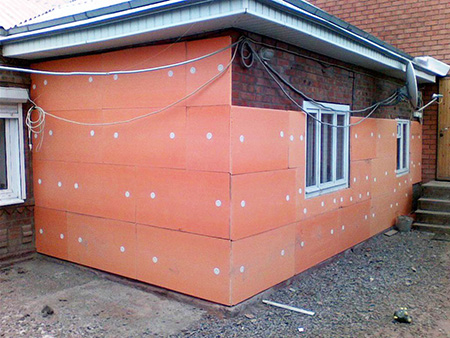
Calculation of materials for thermal insulation
Foam plates have a convenient size of 1 × 1 m and 1 × 0.5 m, which means 1 sq. m and 0.5 sq. m respectively. The number of products must correspond to the area value. It is better to add 10% to the estimated amount of materials for fit. The mesh size for reinforcement is also equal to the area of \u200b\u200bthe walls of the house.
The foam is fastened with plastic dowels, 5 pieces are required for each sheet. The amount of adhesive and plaster mixture depends on the thickness of the applied layer and the manufacturer. The consumable grid is always indicated on the packaging of the formulations.
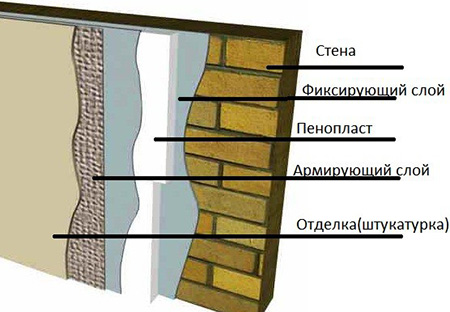
The procedure for wall insulation with foam
Surface preparation for thermal insulation
Universal foam insulation is suitable for installation on any surface of the house: brick, concrete, cinder block. Wall surface preparation is divided into several stages:
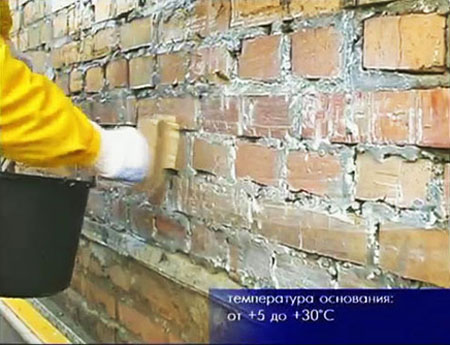
Installation of ebb tides and insulation of slopes
Secure the ebb to plastic window better before installing insulation. It is mounted so that the edge protrudes 3-4 cm beyond the finished wall. This placement protects the finish of the house from the flowing rainwater. At the same time, window slopes are insulated. For this, a distance of 2-3 cm is provided. The facade heat insulator will not work due to its excessive thickness, it is necessary to use a thinner material. Docking with the general insulation of the outer walls will facilitate the protrusion of the foam by 1 cm.
Styrofoam installation methods
The technology of wall insulation with foam outside offers several ways to fix the slabs on the walls with your own hands:
- Adhesive - a universal or special compound for gluing expanded polystyrene is used, for example, Ceresit CM 83. The dry mixture is poured into a bucket of cold water and stirred with a construction mixer or a drill with a nozzle.
- Nailing - plastic dowels with a wide head are used, they are called "umbrellas", "fungi" or disc dowels. A metal or polymer insert is hammered inside the fastener. One plate requires 5 pieces - 4 at the edges and 1 in the middle.
- Combined - the most reliable and common method, it combines the two previous methods.
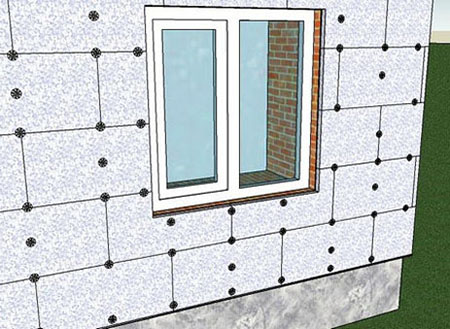
Dowel fixing procedure
Foam bonding
To do the work with your own hands you will need:
- spatula 80 mm;
- large spatula 200 mm;
- solution bucket;
- mixer;
- level.
Special adhesive dry mix Ceresit CM 83 is diluted in a bucket according to the manufacturer's instructions. The consistency of the solution should not be liquid, otherwise the foam sheets will slide down, and excessive density will complicate installation. The normal consistency can be picked up after the first batch. Do not mix a lot of solution at once, it can harden to full use.
The mixture is applied using two spatulas - small it is collected from a bucket and placed on a large one. You can apply the glue to the expanded polystyrene plate or to the wall of the house. The first method is recommended if there is a flat surface without significant differences. The solution is applied with a dotted line along the perimeter of the slab, with an indent from the edge of 2-3 cm. In the central part, random blotches are thrown in an amount of 6-8 pieces. The disadvantage of the method is the weighting of the foam, the installation of the entire insulation will require significant labor costs.
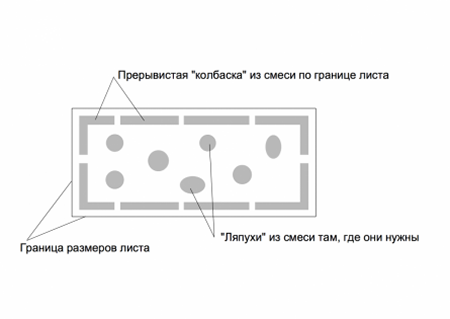
If the wall is crooked, the insulation will not fit well. Irregularities can be corrected by applying the adhesive mixture directly to the insulated surface. Using this method, the thickness of the solution is changed, decreasing or increasing in different areas.
Installation and joining of plates
The process of insulating the exterior walls of the house with foam begins with the installation of the starting bar. It is installed along the entire perimeter of the building using anchors or dowels. The horizontalness of the fastening is checked with a level. The profile will keep the sheets of insulation from slipping until the adhesive mixture dries.

Do-it-yourself installation of plates begins from the bottom of the corner of the house. After applying the glue mixture, the insulation is pressed against the wall and leveled. The plane is controlled by applying a level. Plates are laid with bandaging of seams using the method brickwork... The joints must remain dry, without glue. Having filled the entire surface of the outer wall with insulation, it is left for 3 days to dry.
Fastening with plastic dowels
Disc dowels are a versatile and convenient fastener. With their help, the foam is securely held on the outer walls, allowing you to apply a layer of plaster or install siding. The length of such a "fungus" should exceed the thickness of the insulation by 4-5 cm in order to ensure a strong fastening with supporting structure... To install a plastic dowel in the foam and the wall, a hole is drilled with a perforator with a margin of 2 cm. The fasteners are inserted without a nail and hammered flush with the thermal insulation surface. It is better to use a plastic core with insulation, it will exclude the appearance of a cold bridge. If the nail protrudes above the dowel head, it must be cut off. "Fungi" are placed in two ways:
- on the surface of one slab.
- one in the center, the rest at the joints of adjacent foam sheets.
Which of the schemes is better, everyone decides for themselves, but experts recommend the second method. In this case, the fasteners press the joints, and the plates adhere more tightly to the wall.
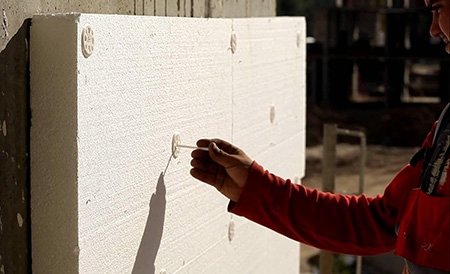
Processing seams and attachment points
After nailing all the foam, inspect the joints of the plates, if the gap between them is more than 5 mm, it is poured with polyurethane foam. When the foam hardens, the protruding part is cut off. Holes of 2 cm or more are filled with scraps of foam. When one of the foam plates protrudes at the junction, the protrusion is removed with a float. When using EPSP, the joints are corrected with a construction knife.
The joints of the plates and the heads of the dish-shaped dowels are putty with an adhesive mixture, trying to wipe out all the irregularities.
Insulation reinforcement
To reinforce the insulation of the exterior walls of the house, you will need fiberglass mesh and a special mixture, for example, Ceresit CT 85. An adhesive mass is applied to the entire surface of the insulation. The fabric of the reinforcing mesh is distributed over the surface without folds and is sunk into the solution. Neighboring strips are laid with an overlap of 5-7 cm, at the corners the mesh is placed on the adjacent wall. To strengthen the corners, it is effective to use a perforated metal corner. The mortar is applied with a wide spatula in a layer of 2-3 mm. Applying the mesh in parts, leave a dry area up to 10 cm. It is coated with a reinforcing mixture when it is applied under the next piece of mesh. After waiting for the composition to dry (1-2 days), the surface is rubbed with your own hands and the leveling layer is applied.
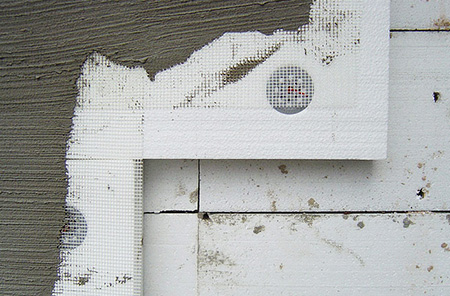
Finish of thermal insulation of external walls
Applying a decorative layer of plaster will help to give an aesthetic look to the house. Before finishing, the surface is treated with a primer. Then putty is applied for painting or decorative plaster... After the outer walls have been insulated, finishing material can be mounted on them.
Features of brick wall insulation for siding
Thermal insulation of a house with polystyrene foam is often performed under metal or vinyl siding. Mounting thermal insulation boards in this case, it occurs after the installation of a frame made of wood or a metal profile. The choice of material depends on climatic conditions - in dry conditions the wood will last a long time, for wet conditions, a galvanized profile is preferable. The size of the lathing depends on the thickness of the insulation, usually it is 50 mm. The foam is fixed between the vertical guides with glue and dowels. Installation technology is similar to that described above. The joints are smeared building mixture... In cold regions, it is recommended to install two layers of insulation.
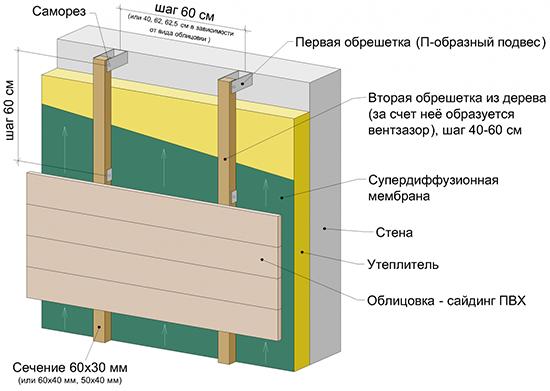
A membrane is stretched over the layer of thermal insulation, which protects against moisture and wind. An air gap is left between it and the foam, created by stuffing the crate. On top of the protective canvas, you need to do it yourself with a crate for siding. Its installation is carried out according to the manufacturer's instructions.
In contact with
Wall insulation with expanded polystyrene outside is most common. After all, the price of the material is quite democratic and all the work can be done by hand.
How to insulate outer wall at home with expanded polystyrene we will consider today in detail. Also, in the video in this article and in the photo, you can clearly see the most important areas of work.
Thermal insulation of walls with extruded polystyrene foam from the outside is not a complicated process, but this is if you are familiar with the technology of work. All work can be divided into several stages, instructions for each of them are set out below.
Preliminary preparation of the wall
Extruded polystyrene foam begins precisely with preparation. This is not just cleaning the plane, it is also necessary to prepare the material itself for further installation.
Attention: Insulation for walls outside with expanded polystyrene is done on a flat plane, differences are allowed, but not more than 5 mm.
After all, it rarely happens that the wall was initially completely flat and preparation, just consists in leveling the wall:
- All kinds of irregularities, depressions and bulges may well lead to the appearance of voids under the insulation material and, as a result, such places can be broken by a blow. Moreover, it does not matter whether it is a depression or the wall protrudes slightly, it needs alignment in both cases. An ideally prepared leveled wall is one where the difference in height is no more than one or two centimeters.
- The wall is well aligned and now the texture of the facade should be taken into account, it will depend on how well the insulation will be glued. So from the painted surface of the wall, paint may well peel off and fall off, such a wall definitely needs a thorough cleaning. PF paint should be knocked off the wall surface in any case (see).
- When you touch a wall completely ready for gluing, not a trace will remain on your hand. In this case, it is quite possible to do without a primer on its surface, but only if your budget is limited, and yet a primer is very, very desirable.
- When there is a trace left by the hand, a primer is required. And if fine grains of sand from under the arm begin to fall from the wall at all, it is necessary to clean up until such an effect disappears and only after that start the primer (see).
- Rarely, but it happens that, no matter how much you clean the shedding, everything will continue, then in no case should you continue to the bitter end, you can overdo it. A preliminary primer is carried out from a spray gun, and then a solid layer is putty or plastered with the addition of PVA glue.
- How to carry out the primer will be described below in the text. The primer itself is applied either with a special brush, or from a spray gun, but the first option is preferable when the wall does not crumble. By applying the primer with a brush, you seem to additionally clean it.
The process of preparing insulation when using extruded polystyrene foam
Sheets of extruded polystyrene foam are distinguished by an increased surface smoothness, and therefore, unlike foam plastic, they need to be prepared for gluing.
Attention: Manufacturers, knowing about such a problem, tried to take this into account and now on sale you can find such insulation material with corrugation, but it is not always available.
- The preparation of extruded polystyrene foam is mainly about making the sheets rough, otherwise the adhesive solution will not adhere well to them. In order to make the sheets rough, they should be rolled with a drywall needle roller.
- The rolling process is not difficult, the sheet is simply rolled over the entire sheet. You should not do everything at the last moment, the sheets are harvested in advance in the right amount for insulation work.
Attention: An important point is that rolling must be done on both sides of the insulation. If you don't have a roller, you can use an iron brush for the same purpose.
Due to its structure, the foam does not need any processing.
Wall priming
The choice of the type of primer depends on the material of the walls, the main thing is that it has deep penetration. When going to priming, run your hand along the wall with little resistance.
- If the hand is dusty or there is a little street dirt on it, the wall should be well washed and dried, and then the primer can be applied only the next day.
- White bloom indicates the presence of mineral deposits characteristic of the weathering of the upper layer. If available, the wall must be treated with a rigid metal cord brush using a drill or grinder. The dust remaining after this is removed, after which you can start priming.
- Concrete or brick walls, silicate or simple brick, with erosion inward, they will leave a gray, red or brown coating on the hand. Such walls are also treated with a metal cord brush, until a solid, unspoiled wall comes through. You can even resort to using a rock drill with a chisel to remove the top layer of the damaged surface.
- After that, the wall is rubbed with cement putty on concrete until it is completely leveled.
Pasting the cornice
Before you start gluing the insulation to the walls, you need to paste over the cornice:
- Pasting is done with the thinnest strips of material on one glue. Extruded polystyrene foam is cut with an electric jigsaw with a blade on foam, or with a hacksaw for metal. PPP can be cut with a regular assembly knife.
- It is necessary to start gluing the strips from the wall, since later they will be supported by wall sheets. WITH
- the vertical strips are first glued, protruding so that the vertical stripes can lie on them. There should be no protrusions for each other.
Working with slopes
The slopes in their original form are not suitable and require some modification:
- So the window sill from the outside should ultimately protrude no more than 4-6 centimeters. For example, you chose sheets of insulation 8 centimeters thick, then the new window sill should be 15-17 centimeters wider than the old one, because 2-3 centimeters just won't go away because of the mesh and plaster.
Attention: Do not make the window sill too protruding, otherwise you risk hearing it well in the house every time it rains.
- When installing a new window sill, you should avoid voids under it.... If they are, they are filled with fragments of foam plastic and filled with foam, otherwise moisture will penetrate there, and the wall will damp. The window sill is immediately installed and pressed down with scrap materials for one day.
- We choose the sheets for gluing the slope so that it does not interfere with the flaps. Glueing is done with a take-off, and after the glue has completely solidified, the foam is cut flush with the wall, or with a minimum offset of 0.5-0.7 centimeters. Thus, after installing wall sheets, they will press the strips to the slope even better.
Work on gluing plates to the wall
After leveling and cleaning the walls, carrying out work with the window sill and slopes, the turn of the walls comes:
- You need to start gluing only in rows from top to bottom, otherwise the coating will creep. Installation of slabs of material is done horizontally with a wider side. Vertical joints between slabs of material are made in a checkerboard pattern, for this the corner slabs are cut in half lengthwise.
- With a wide, from 40 centimeters to one meter, a grooved spatula, glue is applied to the wall, which can be applied to it with a smaller spatula. In the process of applying glue, if it slips in any place, such a place is necessarily greased with an average one. Sour cream is applied to the end of the slab of material, the tile is installed and leveled with gentle swaying for fit.
- For high-quality insulation, one layer of material will not be enough. Therefore, it is better to calculate the amount of material immediately, taking this into account. Since it is necessary to glue in a checkerboard pattern, the upper row of plates is glued with a horizontal shift to the floor of the plate and completely onto sour cream.
- Due to the fact that one layer will not be enough for normal insulation, some might think that you can take plates of different thicknesses. But there is no choice of plates is only one thickness.
Wall insulation outside with expanded polystyrene should be of high quality. After all, the material must be rigidly attached to the plane. Styrofoam is fixed to the wall with dowels-mushrooms converter. At the same time, in many instructions for the material, there is a recommendation to put dowels at the corners, retreating from the edge of the plate.

- Correct fastening is made only in the corners of the slab, so it will be more reliable and the load is distributed among several slabs at once. Only plastic dowels are chosen, since the metal is too susceptible in this case to thermal expansion and destroys the foam. In this case, metal dowels can cut the material, and are not resistant to moisture.
- They should be planted to a depth of at least 6-8 centimeters. With a thickness of insulation of 8 centimeters, 15-16 centimeter dowels are selected. A drill is chosen 20 centimeters, and preferably two at once, since there will be a lot of work and the safety margin of one may not be enough.
- Polyfoam is a rather delicate material, therefore, the dowels-fungi are inserted into the holes obtained by hand, with a rubber hammer to the level of the wall. Then, with the same tool, propylene nails are hammered into the fungi. The resulting unevenness is leveled with a solution.
- At the corners and slopes, the distance between the fungi is from 15 to 30 centimeters, retreating from the corner of 20-22 centimeters along the wall. But it depends on the thickness of the insulation, with the same 8 centimeters, the indent should be 30 centimeters, that is, the dowel must necessarily fall on the slope angle.
Installation of mesh on insulation
After 24 hours, the sanding trowel is equal to the surface of the foam. Even if after that the grater is in poor condition, it should not be thrown away, it is quite useful for leveling the primer under the plaster. After that, you can make a leveling mixture to which the mesh will be glued.
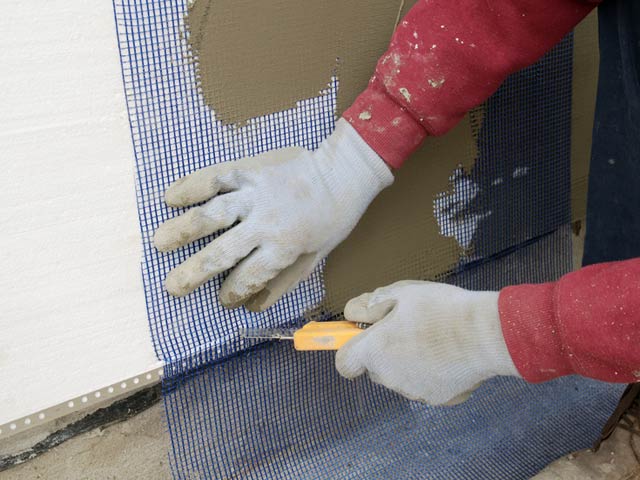
- The gluing process is similar to gluing sheets of insulation, from top to bottom. They start from the corners, and here again a grooved spatula with teeth will come in handy, they apply the mixture to the foam. Then the mesh is pulled and rolled until it fits well onto the material. You can do it and vice versa, first put the mesh and already on it the mixture, but this method is not effective.
- Where winters are harsh, the corners are additionally insulated with special plastic corners with perforation, or the mesh is mounted on sour cream, a day after installation, it is filled with a mixture and rubbed in another day.
- To prevent the joint from protruding, the edges are made free. The edges should overlap each other by two-thirds, a third remains free. When the mixture hardens, they are folded back, smeared and again superimposed on each other, carefully punching to the surface.
Preparation before plastering insulation
For subsequent plastering, it is better to choose a mesh from PVC (see). Such a mesh will not collapse and will not corrode from the cement mixture.
- The length of the mesh strip is cut based on the height of the wall. The mesh is mounted from top to bottom, its strip is held at the top, carefully applying a solution half a centimeter thick, trying to tightly connect the foam to the mesh.
- After the solution has solidified at the top, you can continue to apply it, over the entire surface, starting from the top and along the entire width, leaving only a small part of the edge free.
Attention: The free edge remains only on one side, in order to subsequently superimpose it on the next strip, and so on until the end of the wall.
It is necessary to clarify that it is necessary to start the installation of the mesh precisely from the corners, at the slopes and openings, only then moving on to the rest of the walls.
Grinding before finishing
In order for the laid solution to eventually become even, strong and reliable, it must be subjected to grinding:
- Grinding is done with a plaster trowel, when working it must be moistened from time to time and remember that foam is a delicate material. Grind gently and carefully, without exerting strong pressure when leveling and smoothing the solution.
- The mesh peeking out from under the grout is not a problem and does not require the application of additional grout.
There are tips from people doing this professionally, after that to start priming the entire layer.
Plastering foam insulation
Having made the insulation of the walls with extruded polystyrene foam from the outside, the plane must be plastered (see), because the plane should be perfectly flat. After carrying out all the above procedures, you can make a second or even a third layer before the final leveling of the wall and in order to hide the protruding mesh. The layers are not applied in succession, but only after the previous one has completely dried.
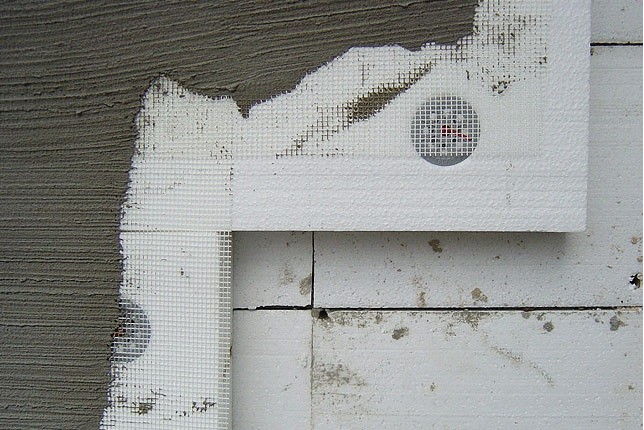
So:
- The application of all these layers should by no means become the final step in wall finishing, but only preparation for the final stage in plastering the wall.... It is allowed to choose decorative plaster for these purposes. After all, many of the previous actions, like the most thorough alignment, were called upon to ensure that the decorative plaster looked high quality.
- For plastering, you must immediately prepare all the necessary material. It is best to choose a plastering composition that is universal, and have several types of spatulas at once. A small spatula is useful for applying mortar to a large one, which is much more convenient than other methods.
- For optimal distribution of the plaster over the entire surface of the wall, a plastering trowel will be useful, preferably made of foam... The reinforcing material will be a polyvinyl chloride mesh. Well, of course, you will need some containers of water to prepare the mixture, an ordinary bucket is quite suitable.
You already know how to insulate the outer walls with expanded polystyrene. By doing the job right, you will cut heating costs. Do everything with high quality and thoughtfulness, only then you will not waste time on rework.
How to insulate walls with foam outside
If the walls of the house are not able to keep warm, then no supermodern heating systems will be able to warm it up. At a low temperature in the room, humidity rises sharply and fungus and mold rapidly develop, affecting not only things and furniture, but also the building itself. Experts say that up to 30% of the heat is lost through the walls, so you should take care of their insulation in a timely manner.
Features of working with foam
Polyfoam is one of the most popular and inexpensive materials. It is an excellent heat insulator, is not afraid of moisture, does not rot and can be easily cut using the simplest tools. However, this material very quickly loses its properties under the influence of ultraviolet radiation, therefore, walls lined with foam are never left open.
Another significant disadvantage of foam is flammability. That is why it is used most often in the so-called wet façade systems, when the foam layer is covered with a layer of plaster fixed on reinforcement mesh... This technology has become very popular due to its ease of decoration and low cost.
Important! Any tree is capable of absorbing and evaporating moisture, i.e. "breathe". Polyfoam has a low vapor permeability, therefore, for cladding wooden house does not apply. In this case, it is better to use glass or basalt wool.
Finishing the house with foam plastic with further plastering (wet facade system)
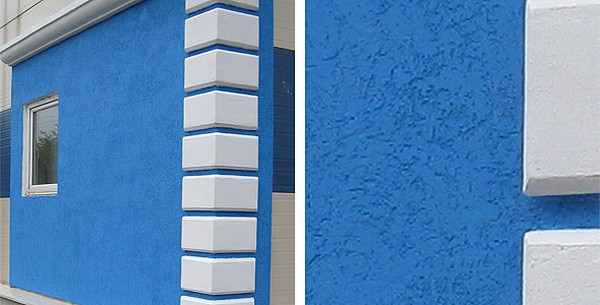
Wet facade system with decorative layer plasters
Consumables
For wall cladding with foam you will need:primer: saving is inappropriate here, it will not only reduce the consumption of glue and prevent the development of fungus, but also strengthen the surface and improve adhesion;
insulation: when laying polystyrene, part of the plate goes for trimming, therefore, for 1 sq. m of the facade will need about 1.05 sq. m of foam; its thickness depends on the climatic zone;
glue;
dowels 6 mm for fixing the profile;
dowels-umbrellas ("fungi"): 1 sq. m will need 5-8 pcs.;
basement (for the bottom of the wall) and corner profiles;
reinforcing mesh: 1.35 sq. m per 1 sq. m of the facade; it is better to take a mesh with a density of 140-160;
a knife for cutting foam;
building level;
putty knife;
plaster: its consumption is indicated on the package, but it should be noted that another 10% will be spent on the processing of slopes;
paint for facade works;
scaffolding, ladder, trestle or scaffolding.
Preparing the walls
Even perfectly laid thermal insulation material will not help to avoid heat loss in the presence of open air channels. Therefore, before starting work, you should carefully plaster or fill with polyurethane foam all existing cracks. In order for the solution to penetrate inside, they are pre-expanded to the desired size.Tap to locate any loose sections of the wall. Loose plaster, soot and mold layers are removed with a metal brush. You can also use a special grinder attachment. In order for the foam to lie flat, too protruding parts of the wall get lost. Oily stains are treated with a solvent. On oil-painted walls, it is better to make small notches with an ax to improve grip.
Wall priming
Concrete and brick walls are best treated with outdoor epoxy compounds that can penetrate deeply into the wall surface. For their priming, you can also use mineral acrylic mixtures for building facades, which provide good adhesion.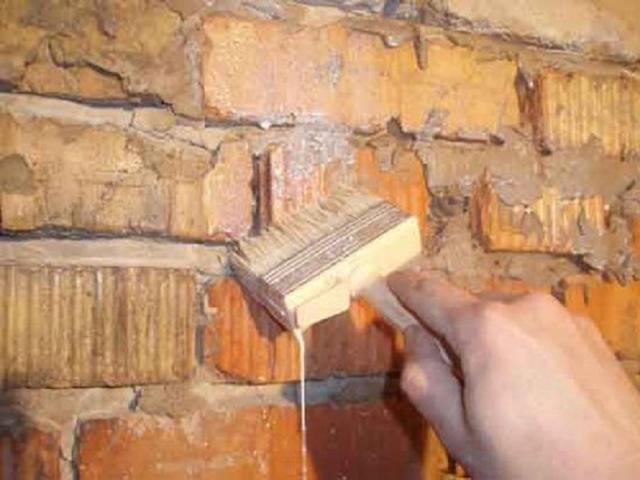
Wall priming
Adhesive selection
You can glue the foam to any walls: concrete, brick, plywood, etc. Before starting work, it is better check the quality of the glue... To do this, smear a small sheet with it, press it against the wall for a few seconds and leave it to dry completely. If, after drying, the foam does not peel off the wall well and its small pieces remain on it, then the glue is of high quality and is chosen correctly.Important! You should carefully study the instructions for use: the glue must be frost and moisture resistant.
For work with foam, you can take any facade adhesives, silicone sealants or liquid nails. For tile joints, polyurethane foam is used. The composition for fixing the foam must not contain organic solvents (acetone, gasoline, ethers, etc.).
The most suitable adhesive is special compound for gluing foam... There are several varieties of it:
1. Universal for foam, which is suitable for both gluing and reinforcement.
2. Glue for gluing. Possesses high plasticity and stickiness, when used, the foam sheets do not slip during the drying process.
3. Adhesive for foam reinforcement: has high strength, but less ductility.

Foam bonding
Wall markings
Corner alignment is not always possible. they may vary slightly. It is better to do the markup in the old old-fashioned way: using plumb lines (lighthouses)... A load is tied to a twine suspended on a dowel at a distance of 5-7 mm from the wall. After it stops swinging, the string is secured.If irregularities are found that do not allow the twine with a load to lie flat, they must be knocked down. Glue or construction foam can be applied to the "holes" of the wall. Cross (horizontal) markings can be applied using hydro level and twine.

Aligning the wall with beacons
Setting up a start profile
A metal profile is attached to the bottom of the wall to support the slabs. In addition, it is able to protect the foam from mice that like to settle in the foam.The size of the profile is selected according to the thickness of the insulation. Fastening is carried out with dowels 6 mm with washers at intervals of 30-40 cm. The corners of the profile are joined using the method of oblique cuts or using an angle connector.
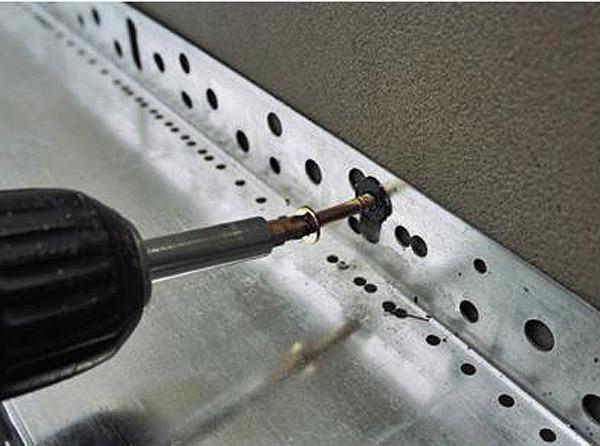
Attaching the starter profile
Methods for applying glue
You can glue the sheet in the following ways:for uneven walls, it is better to apply a sufficiently large layer of glue around the perimeter of the sheet, as well as in several places in its center;
with a spatula with notches, distribute the glue in a small layer evenly over the entire sheet, in this way the foam is glued on even walls;
special adhesive for foam, sold in cylinders, is applied around the perimeter and center of the sheet.

Foam insulation
Before starting work walls must be dry... If you glue the foam on damp, not dried out walls after winter, the adhesive joint will be fragile. When working in the summer heat, changes in day and night temperatures will also not have the best effect on the strength of the not yet dried adhesive composition.All work should be carried out in the spring, about a week after the heating in the houses is turned off. You can also glue the foam in the fall, when the ambient temperature drops to + 17-18 ° C. You should not start work in warm windy weather, as the glue will set too quickly.
It is not recommended to use too brittle foam in the work: it is better to choose a material with a density of 20 kg / m3. Thermal insulation of denser sheets is less, therefore it is better not to use them for insulation of external walls.

Finishing procedure
You can start gluing the foam one day after applying the primer. Plates are laid with the long side of the sheet down, starting from the bottom corner... The second row should go with an offset, as when laying bricks (see photo). For this, the first sheets of odd rows, adjacent to the corners, are cut in half. Slabs with a size of 0.5 × 1 m and a thickness of 5 cm are most convenient to use.
The gaps between the sheets are sealed with foam. Gaps that are too large can be sealed with scraps of foam.
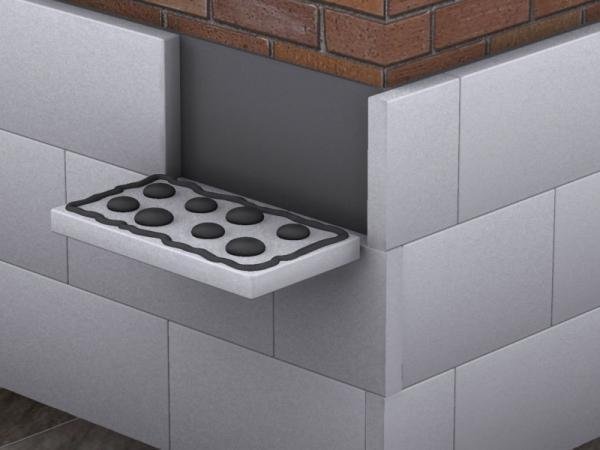
Styrofoam gluing scheme
Additional fixation of foam
For this, "umbrellas" are used - special dowels for foamhaving a plastic head. Their length is selected taking into account the thickness of the slabs. Metal fasteners that can damage fragile plastic are not used. In addition, the metal has a different coefficient of expansion.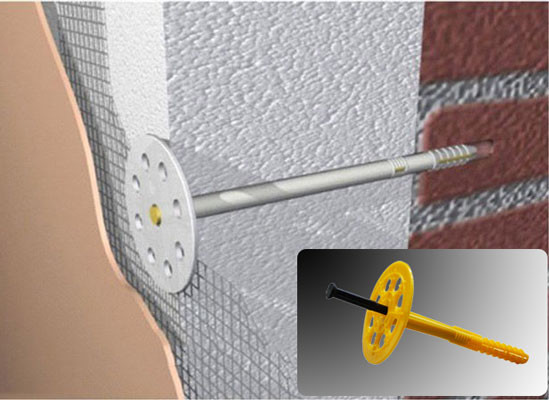
Foam dowels
To install the dowels, holes of the appropriate depth are made in the wall glued with foam plastic, into which the dowels are inserted. They should fit into the foam by 1.5-2 mm.
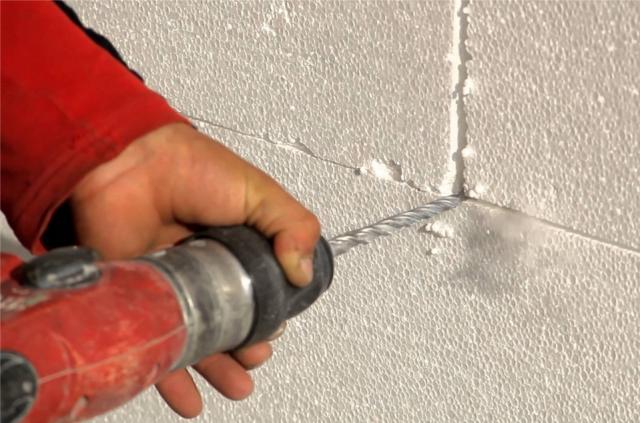
Dowel holes
The "umbrellas" are fastened with an envelope: at the corners of the sheet and in the center. Thus, 5 dowels are required to secure each sheet. The dowels must be included in concrete base to a depth of 50 mm, in brick wall 90 mm. For example, with a foam plastic width of 8 cm, “umbrellas” measuring 13-17 cm are used. After inserting them, they are additionally knocked out with a rubber hammer so that each of them is sunk into the foam plastic by a couple of millimeters.

Creating a decorative protective layer
A day after laying the foam, it is leveled with a grater. The corners of the house are additionally protected with a reinforced mesh with a corner. It is attached with glue and pressed tightly against the jamb with an angled spatula.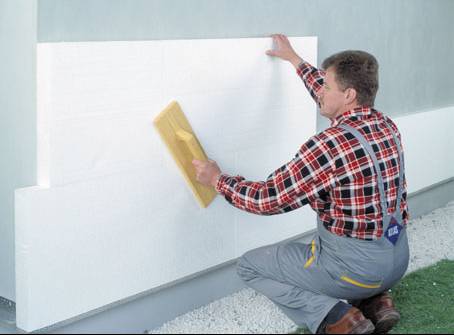
Styrofoam grout
Important! Walls insulated with foam plastic should not be left without finishing for a long time. Even after 2 weeks, ultraviolet rays are already capable of damaging its top layer. If this nevertheless happened, the damaged surface is removed with a float, and only then the wall is lined with mesh.
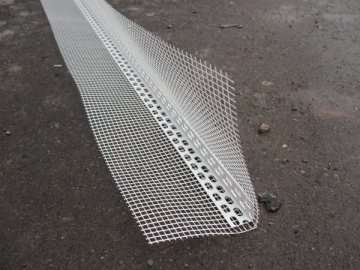
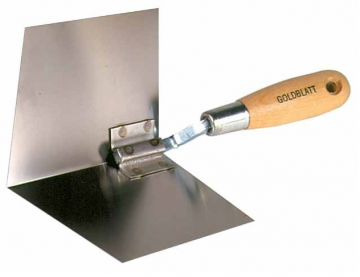
Reinforced corner and corner trowel
Reinforcement of walls insulated with foam is made using a mesh with cells of 3-5 mm. The mesh is cut into strips of the desired width. A special reinforcement glue is applied to the wall so that the mesh sinks into it. Its edges are fixed last. After fixing the mesh on the wall with a spatula, it is leveled and excess glue is removed. Too large a layer can lead to cracking.

Applying reinforced mesh
The second layer of glue is applied only after the first has dried. After 3 days, the reinforced layer is primed, plastered, and then a layer of facade paint is applied to the wall.



